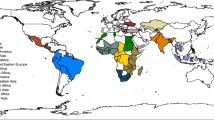Abstract
Babies born live under 2,500 g or with a gestational age under 37 weeks are often inadequately developed and have elevated risks of infant mortality, congenital malformations, mental retardation, and other physical and neurological impairments. In this paper, we model birth weight as a first hitting time (FHT) of a birthing boundary in a Wiener process representing fetal development. We associate the parameters of the process and boundary with covariates describing maternal characteristics and the birthing environment using a relatively new regression methodology called threshold regression. Two FHT models for birth weight are developed. One is a mixture model and the other a competing risks model. These models are tested in a case demonstration using a 4%-systematic sample of the more than four million live births in the United States in 2002. An extensive data set for these births was provided by the National Center for Health Statistics. The focus of this paper is on the conceptual framework, models and methodology. A full empirical study is deferred to a later occasion.
Similar content being viewed by others
References
Balka J (2005) Wiener process cure rate models, Ph.D. thesis, University of Guelph, Guelph, Canada
Chen A, Pennell ML, Klebanoff MA, Rogan WJ, Longnecker MP (2006) Maternal smoking during pregnancy in relation to child overweight: follow-up to age 8 years. Int J Epidemiol 35:121–130
Chhikara RS, Folks JL (1989) The inverse Gaussian distribution: theory, methodology and applications. Marcel Dekker, New York
Cox DR, Miller HD (1965) The theory of stochastic processes. Chapman & Hall London
Gregory KD, Korst LM, Platt LD (2001) Variation in elective primary cesarean delivery by patient and hospital factors. Am J Obstet Gynecol 184(7):1521–1534
Guo Y, Manatunga AK, Chen S, Marcus M (2006) Modeling menstrual cycle length using a mixture distribution. Biostatistics 7:100–114
Harlow SD, Zeger SL (1991) An application of longitudinal methods to the analysis of menstrual diary data. J Clin Epidemiol 44:1015–1025
Kharrazi M, DeLorenze GN, Kaufman FL, Eskenazi B, Bernert JT Jr, Graham S, et al. (2004) Environmental tobacco smoke and pregnancy outcome. Epidemiology 15:660–670
Lawlor DA, Chaturvedi N (2006) Treatment and prevention of obesity—are there critical periods of intervention, Editorial. Int J Epidemiol 35:3–9
Lee M-LT, DeGruttola V, Schoenfeld D (2000) A model for markers and latent health status. J Roy Stat Soc, Ser B 62:747–762
Lee M-LT, Garshick E, Whitmore GA, Laden F, Hart J (2004) Assessing lung cancer risk to rail workers using a first hitting time regression model. Environmetrics 15:1–12
Lee M-LT, Whitmore GA (2004) First hitting time models for lifetime data. Handbook of statistics, Vol 23. Elsevier, pp 537–543
Lee M-LT, Whitmore GA (forthcoming) Threshold regression for survival analysis: modeling event times by a stochastic process, Stat Sci
Lydon-Rochelle M, Holt VL, Easterling TR, Martin DP (2001) First-birth cesarean and placental abruption or previa at second birth. Obstet Gynecol 97(5):Part 1. 765–769
National Institutes of Health (2004) Genomic and proteomic network for premature birth research, release date, June 18, 2004, RFA-HD-04-002, Department of Health and Human Services (DHHS)
National Center for Health Statistics (1980) Factors associated with low birth weight, United States, 1976, DHEW Publication No. (PHS) 80–1915
National Center for Health Statistics (2003) Births: final data for 2002, National Vital Statistics Reports 52(10), December 17, 2003
Savitz DA, Hertz-Picciotto I, Poole C, Olshan AF (2002) Epidemiologic measures of the course and outcome of pregnancy. Epidemiologic Reviews 24:91–101
Scott JR (2002) Putting elective cesarean into perspective. Editorial. Obstet Gynecol 99(6):967–968
Whitmore GA (1983) A regression method for censored inverse-Gaussian data. Can J Stat 11: 305–315
Wilcox AJ, Russell IT (1983) Birthweight and perinatal mortality. I. On the frequency distribution of birthweight. Int J Epidemiol 12:314–318
Wilcox AJ (2001) On the importance—and the unimportance—of birthweight (with commentary). Int J Epidemiol 30:1233–1241
Author information
Authors and Affiliations
Corresponding author
Rights and permissions
About this article
Cite this article
Whitmore, G.A., Su, Y. Modeling low birth weights using threshold regression: results for U. S. birth data. Lifetime Data Anal 13, 161–190 (2007). https://doi.org/10.1007/s10985-006-9032-y
Received:
Accepted:
Published:
Issue Date:
DOI: https://doi.org/10.1007/s10985-006-9032-y
Keywords
- Bayes analysis
- Birth data
- Birth weight
- Competing risks
- Covariates
- Fetal development
- First hitting time
- Gestational age
- Health statistics
- Inverse Gaussian distribution
- Low birth weight
- Mixture model
- Model checking
- Premature birth
- Preterm birth
- Statistical inference
- Statistical model
- Subsampling
- Threshold regression
- Wiener stochastic process
- z-score




